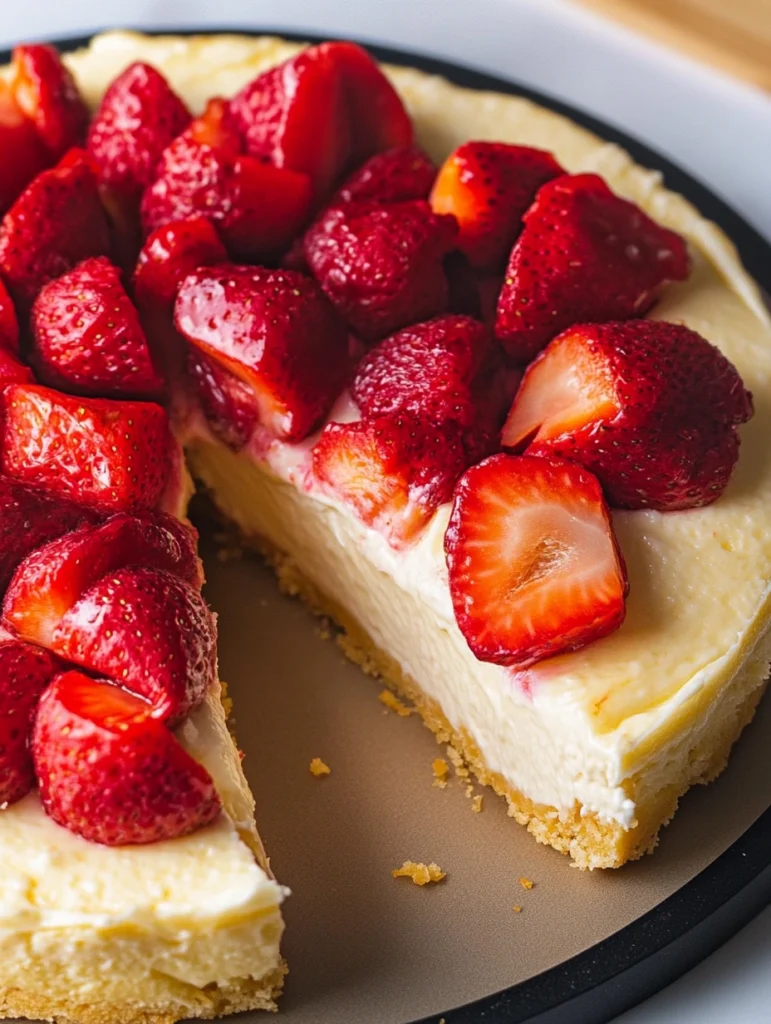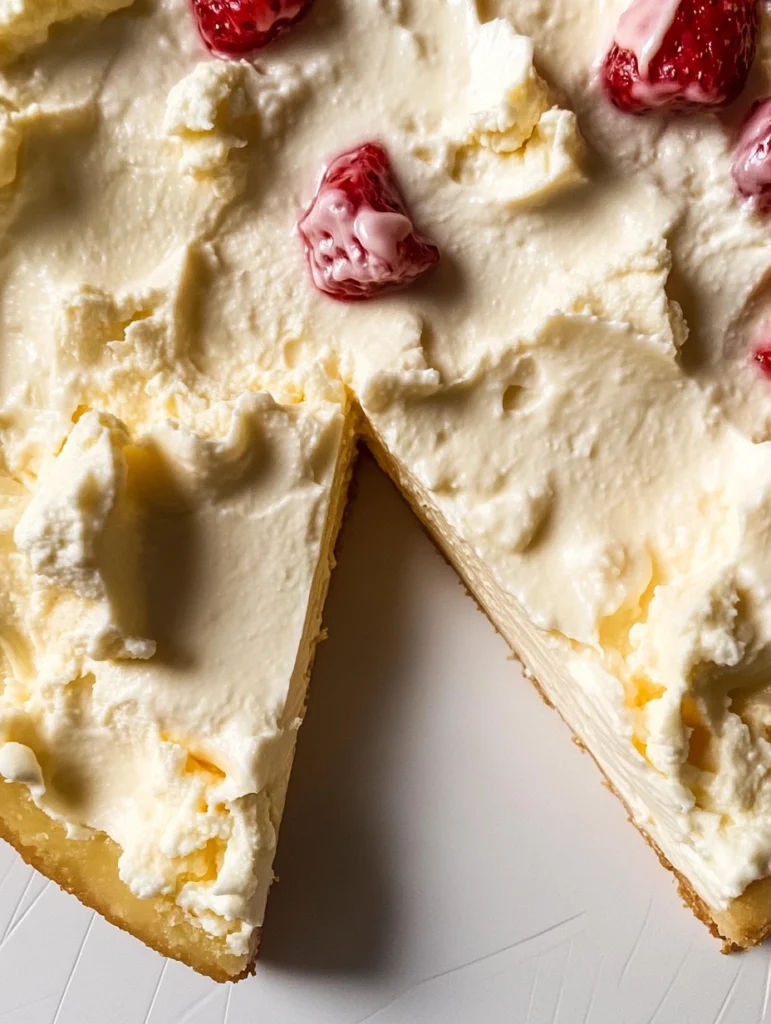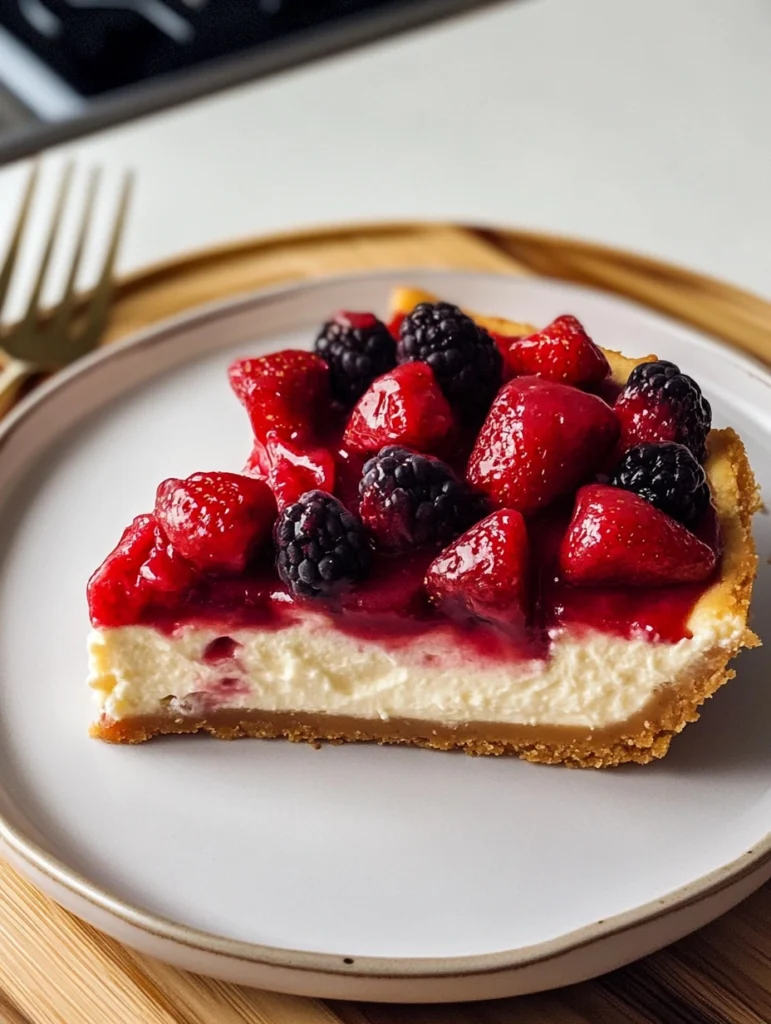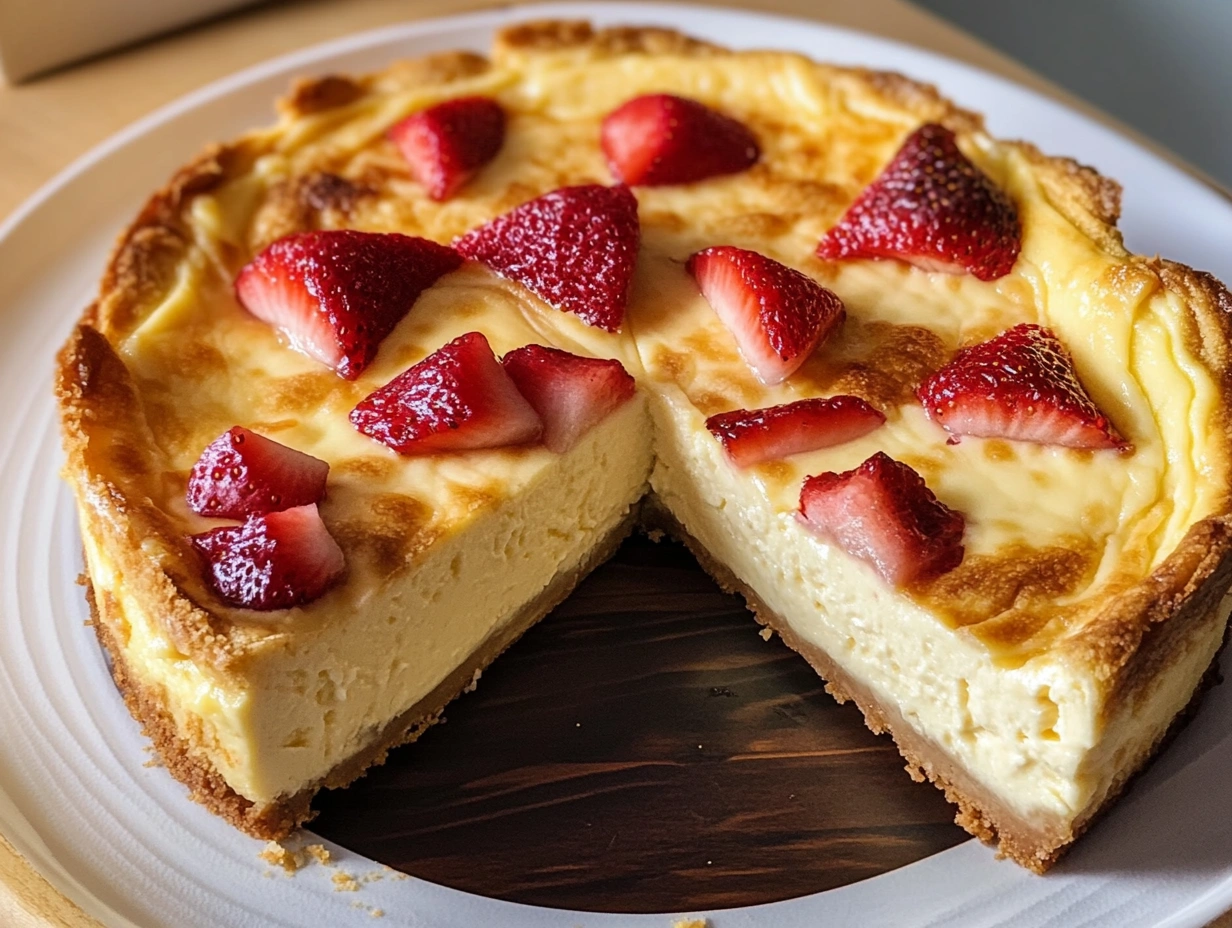Imagine a dessert that’s both sweet and healthy. The cottage cheese cheesecake is your dream come true! It’s a lighter version of cheesecake, packed with protein and still full of flavor.
This dessert uses cottage cheese instead of heavy cream cheese. It’s a game-changer for those who love creamy desserts but want to stay healthy. Each slice is a mix of delicious taste and good nutrition, making it a guilt-free choice.
If you’re into fitness, love healthy food, or just enjoy tasty desserts, you’ll love cottage cheese cheesecake. It’s a treat that shows that healthy eating can be incredibly tasty!
Key Takeaways
- Cottage cheese cheesecake offers a healthier alternative to traditional cheesecake
- Contains approximately 159 calories per slice
- Provides 6.5 grams of protein per serving
- Lower in fat and sugar compared to classic cheesecake recipes
- Easy to prepare with simple, nutritious ingredients
- Suitable for health-conscious dessert lovers
Table of Contents
Understanding cottage cheese cheesecake and its origins
Explore the world of cottage cheese dessert, a treasure from Eastern European cuisine. It has a long history, starting as a simple breakfast to a modern favorite.
History of Cottage Cheese in Baking
Cottage cheese has been used in baking for many years. Its texture and health benefits make it perfect for desserts. Ancient Greeks and Romans used cheese in their cooking.
- Ancient Greeks used cheese in early cake-like preparations
- Roman recipes included cheese in religious and celebratory dishes
- Cottage cheese provided a protein-rich base for baked goods
Traditional Eastern European Roots
In Eastern Europe, the cottage cheese cheesecake, known as Zapekanka, became a favorite. It was enjoyed for breakfast and dessert. Ukrainian and Russian cuisines made it a lasting tradition.
| Region | Traditional Name | Key Characteristics |
|---|---|---|
| Ukraine | Zapekanka | Rustic, simple ingredients |
| Russia | Cottage Cheese Casserole | Hearty, protein-rich dessert |
Modern Healthy Dessert Evolution
With the rise of health trends, cottage cheese cake evolved. It became a protein-rich, lower-fat option. Now, it’s loved by fitness fans and those looking for a healthy treat.
From humble beginnings to a modern culinary sensation, the cottage cheese dessert continues to reinvent itself.
Health benefits and nutritional value
Discover why cottage cheese desserts are a game-changer in healthy protein desserts. This treat is packed with nutrients, offering more than just taste. It’s a powerhouse of nutrition for guilt-free indulgence.

High Protein Content and Essential Nutrients
Cottage cheese is a top-notch protein source, unlike traditional desserts. A single serving brings remarkable nutritional benefits:
- Contains all nine essential amino acids
- Offers 14 grams of protein per half-cup serving
- Provides 29% of daily vitamin B12 requirements
- Supports muscle building and repair
Nutritional Comparison with Traditional Cheesecake
| Nutrient | Cottage Cheese Cheesecake | Traditional Cheesecake |
|---|---|---|
| Calories | 81 per 1/2 cup | 300-400 per slice |
| Protein | 14g | 5-7g |
| Fat | 1g | 20-25g |
Dietary Considerations and Benefits
Your cottage cheese dessert is not only tasty but also nutritious. With over 70% of its calories coming from protein, it aids in weight management and muscle health. Studies show high-protein diets can help females lose up to 6.2 lbs and males up to 3.1 lbs.
As a bonus, cottage cheese desserts are naturally gluten-free and vegetarian. They’re perfect for athletes, pregnant women, or anyone looking for a nutritious treat. This dessert offers exceptional value.
Essential ingredients for the perfect cottage cheese cheesecake
Making a great cottage cheese cheesecake begins with picking the right ingredients. Success comes from using top-notch parts that blend for a creamy, tasty dessert. Let’s look at the main ingredients that make your cottage cheese cake a hit.
- Cottage Cheese: The main ingredient, best at 2% milkfat for great taste and texture
- Greek Yogurt or Sour Cream: Adds creaminess and a tangy flavor
- Eggs: They help hold the filling together
- Sweetener: Maple syrup or honey are great choices
- Cornstarch or Potato Starch: Keeps the filling stable
Choose a high-quality cottage cheese for your cheesecake. Use 2 pounds for a rich, satisfying cake. A 2% milkfat cottage cheese is the best for flavor and smoothness.
| Ingredient | Quantity | Purpose |
|---|---|---|
| Cottage Cheese | 2 lbs | Primary base, provides protein |
| Sugar | ½ cup | Sweetens the cheesecake |
| Greek Yogurt | ½ cup | Adds creaminess |
| Potato Starch | 2 tablespoons | Stabilizes filling |
Pro tip: Each ¼ cup of cottage cheese has about 6 grams of protein. This makes your cheesecake a healthy dessert choice. Try different sweeteners and fat levels to find your favorite!
Step-by-step preparation method
Making a tasty cottage cheese cheesecake needs attention to detail. This guide will help you make a creamy, protein-rich dessert. It will surely please your taste buds.
Crust Preparation Techniques
Your cheesecake starts with a great graham cracker crust. Here’s how to make it:
- Crush 11 full graham wafer sheets into fine crumbs (approximately 1.5 cups)
- Mix crumbs with 1/4 cup sugar
- Add 5 tablespoons of melted butter
- Press the mixture firmly into a 9-inch springform pan
Blending the Perfect Filling
The filling is where the magic happens. Mix these ingredients for a smooth texture:
- 3 cups cottage cheese
- 1/2 cup Greek yogurt
- 1 cup sugar
- 2 teaspoons vanilla extract
- 1 tablespoon lemon zest
- 4 large eggs
Blend until completely smooth. This ensures a silky texture in your cheesecake.
Baking Tips and Temperature Control
Getting the baking just right is key to a perfect cheesecake.
| Baking Parameter | Specification |
|---|---|
| Temperature | 350°F (180°C) |
| Baking Time | 50-55 minutes |
| Serving Size | 1 slice (approximately 195 calories) |

Pro tip: Use a water bath to prevent cracking and ensure even baking. Let the cheesecake cool completely before refrigerating.
Cottage cheese cheesecake variations and serving suggestions
Make your cottage cheese cake even better with new twists. These changes can make your dessert healthier or tastier. You can choose from many options to find your favorite.
Popular Cottage Cheese Cheesecake Variations
- Crustless Version: Perfect for low-carb enthusiasts
- Keto-Friendly Option: Reduced carbohydrate alternative
- Protein Powder Enhanced: Boost nutritional value
Want more protein? Add a scoop of protein powder to your cake. This makes your dessert not only delicious but also packed with nutrients.
Delightful Serving Suggestions
Try these tasty toppings to make your cottage cheese dessert even better:
- Fresh berries (strawberries, blueberries)
- Sugar-free fruit compote
- Whipped cream
- Nut butter drizzle
- Protein frosting
“A great cottage cheese cake is like a canvas – ready for your culinary creativity!” – Dessert Enthusiast
Pro tip: Try different protein powders for unique flavors. Vanilla, chocolate, or unflavored can change your cake’s taste.
Nutritional Customization
Change ingredients to meet your dietary needs. You can make it low-sugar or high-protein. The choices are endless.
Storage tips and shelf life recommendations
To keep your cottage cheese dessert fresh, follow some key storage tips. These methods help you enjoy your homemade cottage cheese cheesecake for several days.

Refrigeration Strategies
When it comes to your cottage cheese cheesecake, refrigeration is crucial. The USDA says to keep it at temperatures below 40°F. This helps keep it fresh and prevents bacteria from growing.
- Store in an airtight container
- Place in the coldest part of your refrigerator
- Consume within 4-5 days of preparation
Freezing Recommendations
Freezing is an option, but you need to prepare it right to keep the cheesecake’s texture and taste.
- Chill the cheesecake for 1-2 hours before wrapping
- Use multiple layers of protection:
- Plastic wrap
- Aluminum foil
- Sealed freezer bag
- Freeze for up to 3 months
- Thaw overnight in the refrigerator
Freshness Indicators
Know when your cottage cheese dessert is no longer fresh:
- Unusual odors
- Visible mold
- Significant texture changes
- Watery separation
Remember, your cheesecake should never stay at room temperature for more than 2 hours. Always put food safety first to enjoy your cottage cheese cheesecake worry-free.
Conclusion
Cottage cheese cheesecake is a tasty change in dessert making. It has about 28 grams of protein per serving. This makes it a healthy treat that you can enjoy without feeling guilty.
This dessert is great for anyone who loves sweets and fitness. It’s perfect for those who follow a keto diet or want a low-carb option. You can also make it with almond flour crusts and sugar-free sweeteners to fit your diet.
Don’t stop here in your cooking journey. Cottage cheese can change your baking game. Choosing cottage cheese cheesecake means you’re picking a dessert that’s good for you. Start baking healthier desserts today!
FAQ
What exactly is cottage cheese cheesecake?
Cottage cheese cheesecake is a healthier version of traditional cheesecake. It uses cottage cheese as the main ingredient. This dessert is creamy and rich, yet has more protein and fewer calories than regular cheesecake.
Is cottage cheese cheesecake actually healthy?
Yes, it is! Cottage cheese cheesecake is much healthier than traditional cheesecake. It’s high in protein, has less fat, and has fewer calories. The cottage cheese adds important nutrients and helps you feel full longer.
Can I make a cottage cheese cheesecake if I’m lactose intolerant?
Yes, you can make a lactose-friendly version. Use lactose-free cottage cheese or Greek yogurt instead. You can also add lactase enzyme drops or choose low-lactose cottage cheese for better digestion.
How long does cottage cheese cheesecake last in the refrigerator?
It lasts 3-5 days in the fridge if stored in an airtight container. Keep it covered and at 40°F or below. For the best taste, eat it within 2-3 days.
Can I freeze cottage cheese cheesecake?
Freezing is not recommended. The texture may become watery and grainy when thawed. If you need to freeze it, wrap it tightly and consume it within one to two months. Thaw in the fridge and expect texture changes.
What are some popular variations of cottage cheese cheesecake?
Try crustless, keto-friendly, protein-packed, or flavored versions. Add lemon zest, vanilla, or berries for different tastes. Use almond flour or graham cracker crusts for variety.
Is cottage cheese cheesecake a good option for weight loss diets?
Yes, it’s great for weight loss diets. It’s high in protein, low in calories, and keeps you full. Just control portion sizes and use low-fat cottage cheese.
How can I make my cottage cheese cheesecake extra creamy?
For extra creaminess, blend cottage cheese until smooth. Use full-fat cottage cheese and add Greek yogurt or cream cheese. Strain the cottage cheese for a smoother texture. Use a food processor or blender to avoid lumps.

